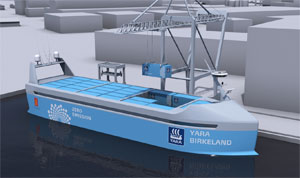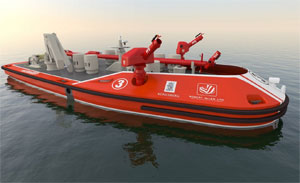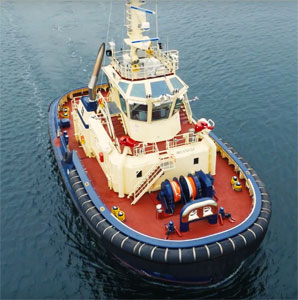There’s a tidal wave of maritime autonomous surface ships (MASS) that is about to come crashing down on professional mariners in America and all over the world. Like other tidal waves, MASS cannot be stopped. Hopefully it can be regulated and controlled, though, for the sake of vessel safety and maritime employment. That control can only happen if we meet the wave head on.
MASS directly threatens professional merchant mariner jobs. It’s specifically designed to replace the human element. By doing so, it will decrease the safety and security of most types of vessels converted to MASS, while eliminating maritime careers. It also will directly conflict with the international treaty to render aid to those in need at sea.
Some people are mildly concerned about MASS, but most are not concerned at all. They truly believe it is years away. Unfortunately for mariners, they are already losing jobs to various types of autonomous ships. Not all robot vessels being planned are cargo vessels, either — sadly, even tugboat jobs aren’t safe.
Rolls-Royce and global towing provider Svitzer have operated the 92-foot Svitzer Hermod in Copenhagen, Denmark, by remote control. The vessel’s captain was stationed at Svitzer headquarters while he operated the tug with no crew on board. Keppel Offshore & Marine, through wholly owned subsidiary Keppel Singmarine, is also developing and constructing an autonomous tugboat. It will be operated by Keppel Smit Towage. The project will be completed in 2020, with the tug operating in Singapore.
Another autonomous vessel in the works is a fireboat from Robert Allen Ltd. and Kongsberg Maritime. The 65-foot vessel will have a fire monitor mounted on a retractable mast for hard-to-reach hot spots. The RALamander 2000 fireboat also will be equipped with twin propellers and forward and aft side thrusters for pinpoint maneuvering. Then there are the more obvious cargo vessel jobs being targeted, which will be eliminated sooner than most people think. A 262-foot autonomous containership, Yara Birkeland, is being built right now. It will begin manned operations in Norway in 2020, transitioning to fully autonomous operation by 2022.
These examples are not just chalkboard plans; they are MASS realities affecting current and future jobs, and it’s just the tip of the iceberg.
Many good research vessel jobs already have been eliminated by autonomous underwater vehicles (AUVs). They started out small at about 3 feet in length, and they grew fast. Many would argue that these small AUVs provide valuable data in a niche that does not threaten research vessel jobs — they can ply shallow waters where larger vessels cannot go, they can be programmed with remarkable accuracy and they can repeat plotted courses beyond human capability. That might be true, but they also have grown exponentially in size and number from their 3-foot ancestors. Another reason for their meteoric rise is that they are vastly less expensive to operate. This simple fact means that they will soon be everywhere. Combined with the growing number of autonomous surface vessels of all types being constructed, new safety and security issues are arising.
The first safety problem that comes to mind with regard to robot ships is the possibility of collisions at sea. MASS designers are keenly aware of this and have taken steps to protect their assets. Many have developed forms of artificial intelligence maneuvering (AIM), and it’s encouraging to know that computers can be programmed to receive data from various sources, interpret that data and execute maneuvers to avoid collisions. That technology is moving along, but it is by no means where it needs to be for every collision scenario — nor is it keeping pace with the number of AUVs in operation for research purposes. So, what are the international laws concerning the operation of MASS and AUVs and the requirements of AIM?
 |
|
Yara Birkeland is slated to be the world’s first fully electric and autonomous containership. The 262-foot vessel, a collaboration between Norway-based Yara and Kongsberg Maritime, will have a cargo capacity of 100 to 150 TEUs and a top speed of 10 knots. Vard will deliver Yara Birkeland for service in early 2020, and the vessel will gradually move from manned operation to fully autonomous operation by 2022. |
|
Courtesy Kongsberg Maritime |
News flash: There are none. The International Maritime Organization (IMO) is working on it, however. The IMO has delegated the task of studying MASS and AUV issues to its Maritime Safety Committee (MSC). The panel’s work has been steady but far too slow. So far, the MSC has agreed on the following definitions:
• Degree one: A ship with automated processes and decision support. Seafarers are on board to operate and control shipboard systems and functions. Some operations may be automated and at times be unsupervised, but seafarers are aboard the vessel and ready to take control.
• Degree two: A remotely controlled ship with seafarers on board. The ship is controlled and operated from another location, but seafarers are available to take control and to operate the shipboard systems and functions.
• Degree three: A remotely controlled ship without seafarers on board. The ship is completely controlled and operated from another location.
• Degree four: A fully autonomous ship. The operating system of the vessel is able to make decisions and determine actions by itself.
The MSC was scheduled to meet again in London in June to continue its work. In the meantime, MASS and AUV collisions will have to be adjudicated by judges or juries relying on expert witness testimony. They will have to determine fault by extrapolating the 1972 COLREGS (International Regulations for Preventing Collisions at Sea) for crewed vessels.
It isn’t known if the MSC has even broached the subject of how autonomous vessels can possibly comply with the international treaty requiring the rendering of aid to other vessels in peril. Is the committee just going to exempt MASS? Do we really want robot ships to steam by mariners floating in the water and waving for help?
Other safety concerns are brought up if professional mariners are taken out of the equation. Computers are subject to malfunctions. If AIM breaks down and there’s no one on board to repair it or take control of the ship, then that can result in a serious loss. What if AIM is working perfectly and the engine breaks down instead? How are vessel owners going to get a team of licensed engineers on board a ship in the middle of the ocean during a storm? Are you just going to let your ship be tossed about until it sinks? And what happens if there is a fire without crewmembers on board? Fires at sea are extremely dangerous. Automatic fire suppression systems only go so far — they can’t be in every shipping container. There really is no substitute for a well-equipped and well-trained firefighting crew.
Having humans on board can protect a ship in other ways, too. Security team members can fight off pirates and other unauthorized boarders, and they can prevent merchant vessels equipped with AIM from being turned into terrorist tools in the event the ships are hacked. These possible security breaches concerned me so much that I decided to reach out to the U.S. Coast Guard for some answers.
 |
|
Robert Allan Ltd. and Kongsberg Maritime are developing a remotely operated fireboat that will allow first responders to more safely attack port fires. The 65-foot RALamander 2000 will have a range of automatic functions including “line protection,” where the vessel automatically moves back and forth while directing spray cover. |
|
Courtesy Robert Allan Ltd. |
“Autonomous technology is currently under discussion in various International Maritime Organization committees, where they are beginning to wrestle with the very issues you raise,” said Coast Guard spokeswoman Lt. Amy Midgett.
“While there are no answers as of yet, the weighty importance of the questions is well recognized and at the forefront of the discussion,” she continued. “When it comes to charting a course to develop standards and regulations, the advancement of vessel autonomy presents several new challenges for ensuring the continuity of safety and security in the Marine Transportation System. These challenges include consideration of stakeholder concerns, the regulatory framework, industry best practices, international standards and eventually specific regulatory standards. These are complex challenges with many factors to consider in order to ensure the safe deployment and implementation of autonomous technology.”
Given the lack of regulations, you might think that insurance companies would never cover a multimillion-dollar vessel without any crew on board, but that is not the case. Lars Gustafson, U.S. marine practice leader for Illinois-based Gallagher, said his company would insure MASS vessels, and some of his answers about protection and indemnity (P&I) — which is the technical term for hull and cargo insurance — might take professional mariners by surprise.
When assessing vessel risk, Gustafson said insurers would look at possible future scenarios involved with MASS, but the premiums would be mostly based on facts, not conjecture. The statistical track record is of primary importance, not the fear of the unknown. He then gave a very apt example of what he meant.
Liquefied natural gas (LNG) vessels were confronted with much the same safety and insurance concerns when they were first built. Most marine insurance companies covered them but at an inflated rate. LNG vessel owners and operators paid up to four times the normal rate for P&I. As time went on and a statistical track record of LNG operations was amassed, the rate dropped precipitously. Soon the insurance cost for LNG vessels was less than other merchant vessels, due directly to LNG’s strong safety record.
Gustafson sees MASS starting in a similar way. Crew injury liability may be eliminated and autonomous safety concerns may increase, but they will balance out. The pattern of high rates in the beginning and then lower rates later on will continue if MASS can prove itself just like LNG vessels did. So, if you thought that vessel insurers were going to save mariner jobs by refusing to cover MASS, you were wrong.
Right now there is a long list of concerns about MASS, led by vessel safety and vessel security issues. MASS laws and international treaty compliance remain in limbo, and the very important question of our future professional maritime careers has yet to be fully answered.
Capt. Marc Deglinnocenti is a maritime technical writer who recently served as a panelist at a forum on autonomous vessels at the Ship Operations Cooperative Program (SOCP). His sea time dates to 1974 in a wide variety of roles on sailboats, conventional and tractor tugboats, training ships, barges, warships, cargo ships, passenger vessels and research vessels. He can be reached at oldarmada@gmail.com.

